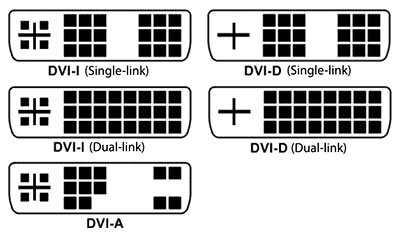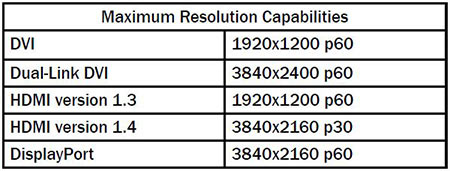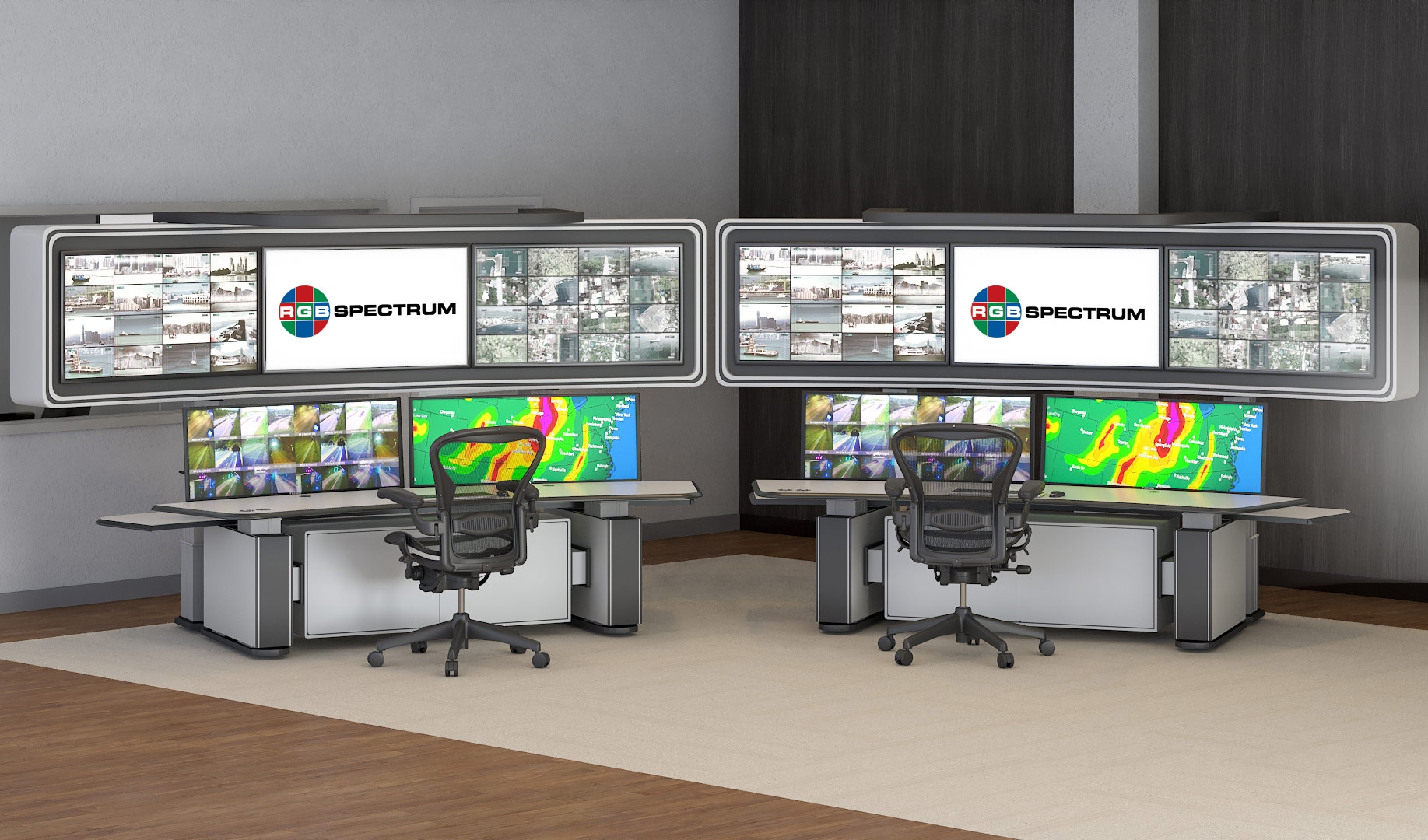Visual Technology Tutorial, Part 2: Signal Interfaces
This is Part 2 of a video processing technology training series extracted from RGB Spectrum's Design Guide.
Signal Interfaces
DVI
Digital Visual Interface (DVI) was developed in 1999 as a convenient interface for the transfer of uncompressed digital video signals. The DVI specification also provides optional compatibility with the VGA interface for analog video.
A DVI connector may have up to 29 pins that transmit signals, although not all pins are used in all cases. There are five different DVI connectors:

- DVI-A: analog only; content is found on the four-pin group that is separate from the main pin group.
- DVI-D (single-link & dual-link): digital only; the four-pin group is only sometimes present, but no content is carried on it.
- DVI-I single-link: analog and digital; both pin groups active.
- DVI-I dual-link: digital with or without analog; two DVI digital links are provided to support high resolutions.
Although DVI was originally developed as a computer interface, became a common connector on many professional electronic devices as well. As outlined above, there are two types of links in the DVI specification to support different resolution requirements, namely single-link and dual-link. Single-link connections can support a maximum pixel rate of 165 MHz for resolutions up to 1920x1200 and 24-bit color. Dual-link connections can support a maximum pixel rate of 330 MHz, and resolutions up to 3840x2400 although the more common resolution is 2560x1600. Dual-link does not mean “dual cables”; both types of link use a single physical DVI connector. The difference lies primarily in the pin count, configuration, and maximum resolutions supported.
Industry Challenge: Graphics cards and other high resolution sources output dual-link DVI signals but many video processors do not handle these high-speed interfaces.
RGB Spectrum Solution: RGB Spectrum products incorporate dual-link DVI interfaces to provide support for the highest resolution signals up to 4K/Ultra HD.
HDMI®
High Definition Multimedia Interface (HDMI®) is an evolution of DVI developed in 2002 specifically for consumer electronics devices. Like DVI, HDMI® uses Transition Minimized Differential Signaling (TMDS), a high-speed serial link developed by Silicon Image. However, they differ in significant ways:
- HDMI® is not compatible with analog VGA signals.
- DVI is limited to the RGB color space. HDMI® supports RGB, but also supports YCbCr (see “Color Models” on page 7), a digital color space that is widely used in the broadcast video industry.
- HDMI® can carry digital audio signals, DVI cannot.
- An HDMI® connector is much smaller than a DVI connector, and can be less robust in professional/ commercial applications.
There are five different types of HDMI® connectors defined by the standard. However, the most common connectors used in AV installations are the Standard (Type A) and Mini (Type C) connectors.
DisplayPort, first approved in 2006, is the newest digital video interface. Developed by the Video Electronics Standards Association (VESA), it has started to replace older standards like DVI and VGA. Unlike DVI and HDMI®, which uses TMDS, DisplayPort relies on packetized data transmission, which allows the interface to pass more data (and achieve higher resolutions) on fewer pins. Like HDMI®, it can be used to transmit both video and audio. DisplayPort has become a common port on graphics cards, computers, and displays. Apple® adopted a smaller version in 2008, called Mini DisplayPort (or mDP), which is currently available on many Apple and other products. Support for stereo 3D video has also been incorporated into the current standard.
One of the key physical features of the DisplayPort interface is a locking connector that is physically smaller than a DVI connector. Also, DisplayPort uses a single clock frequency, which lowers the cost of transmitters and receivers. DisplayPort HBR3 mode in version 1.3 can support resolutions up to 4K UHD (3840x2160) at 120Hz. It can also directly transmit HDMI®, DVI or VGA signals using a simple dongle adapter. While full-bandwidth transmission is limited to about 3 meters of cable length, information can be transmitted up to 33 meters using active cables.
The following chart summarizes the maximum resolutions supported by DVI, different versions of HDMI® and DisplayPort interfaces:

SDI / HD-SDI
Serial Digital Interface (SDI) is a family of video interfaces defined by the Society of Motion Picture and Television Engineers (SMPTE) in 1993. Its primary applications are in the professional broadcast television industries, although it is also commonly used in live-event production, medical imaging, and other high-end applications. The original SMPTE 259 (SDI) is a serial, one-way protocol that provides data rates of up to 360 Mbps.
Other SMPTE SDI standards with higher bitrates have been introduced and are known as HD-SDI, 3G-SDI, 6G-SDI, and 12G-SDI. The latest standard, SMPTE ST-2083 (24G-SDI) is in development with a proposed bitrate as high as 24 Gbps. All versions of SDI use one or more coaxial cables with BNC connectors and a nominal impedance of 75 ohms.
HDBaseT
HDBaseT is the latest innovation in connectivity technology, and it has been adopted by many consumer and professional video electronics manufacturers and installers. The first specifications were finalized in June 2010 with the goal of establishing a new global HD digital connectivity standard.
HDBaseT is capable of transmitting uncompressed UHD digital video, audio, 100BaseT Ethernet, USB, up to 100 watts of power, and control signals (RS232, IR) through a single 100m/328ft CAT-6 cable with RJ45 connectors (common network cable). Video is passed through from an HDMI® chipset, so it supports the same resolutions as HDMI® 1.4. HDBaseT also supports 4K video at 30 fps, new 3D formats, Consumer Electronics Control (CEC) and Display Data Channel (DDC) standards.
Fiber Interfaces
Fiber optic systems transmit information using pulses of light traveling through optical fiber cables. Fiber optic transmission technology offers a number of benefits over other transmission media (i.e. copper, CAT-6, etc):
- Long-distance transmission — Depending on the type of cable used, information can be transmitted anywhere from several hundred meters to many kilometers without signal degradation.
- Secure transmission — Signals traveling over fiber optic cable do not generate electro-magnetic fields. For this reason, signals can’t be detected externally, which makes fiber transmission more secure than transmission over copper cables.
- Logistics — Fiber optic cables are thin and lightweight which simplifies installations; multiple channels can be pulled through a small-diameter conduit.
RGB Spectrum is a leading designer and manufacturer of mission-critical, real-time audio-visual solutions for a civilian, government, and military client base. The company offers integrated hardware, software, and control systems to satisfy the most demanding requirements. Since 1987, RGB Spectrum has been dedicated to helping its customers achieve Better Decisions. Faster.™


